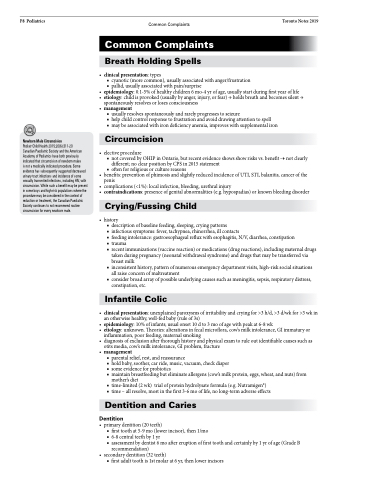Page 1042 - TNFlipTest
P. 1042
P8 Pediatrics
Common Complaints
Toronto Notes 2019
Newborn Male Circumcision
Pediatr Child Health 2015;20(6):311-20
Canadian Paediatric Society and the American Academy of Pediatrics have both previously indicated that circumcision of newborn males
is not a medically indicated procedure. Some evidence has subsequently suggested decreased urinary tract infections and incidence of some sexually transmited infections, including HIV, with circumcision. While such a benefit may be present in some boys and high-risk populations where the procedure may be considered in the context of reduction or treatment, the Canadian Paediatric Society continues to not recommend routine circumcision for every newborn male.
Common Complaints
Breath Holding Spells
• clinicalpresentation:types
■ cyanotic (more common), usually associated with anger/frustration ■ pallid, usually associated with pain/surprise
• epidemiology:0.1-5%ofhealthychildren6mo-4yrofage,usuallystartduringfirstyearoflife
• etiology:childisprovoked(usuallybyanger,injury,orfear)→holdsbreathandbecomessilent→
spontaneously resolves or loses consciousness • management
■ usually resolves spontaneously and rarely progresses to seizure
■ help child control response to frustration and avoid drawing attention to spell
■ may be associated with iron deficiency anemia, improves with supplemental iron
Circumcision
• electiveprocedure
■ not covered by OHIP in Ontario, but recent evidence shows show risks vs. benefit → not clearly
different; no clear position by CPS in 2015 statement ■ often for religious or culture reasons
• benefits: prevention of phimosis and slightly reduced incidence of UTI, STI, balanitis, cancer of the penis
• complications (<1%): local infection, bleeding, urethral injury
• contraindications:presenceofgenitalabnormalities(e.g.hypospadias)orknownbleedingdisorder
Crying/Fussing Child
• history
■ description of baseline feeding, sleeping, crying patterns
■ infectious symptoms: fever, tachypnea, rhinorrhea, ill contacts
■ feeding intolerance: gastroesophageal reflux with esophagitis, N/V, diarrhea, constipation
■ trauma
■ recent immunizations (vaccine reaction) or medications (drug reactions), including maternal drugs
taken during pregnancy (neonatal withdrawal syndrome) and drugs that may be transferred via
breast milk
■ inconsistent history, pattern of numerous emergency department visits, high-risk social situations
all raise concern of maltreatment
■ consider broad array of possible underlying causes such as meningitis, sepsis, respiratory distress,
constipation, etc.
Infantile Colic
• clinicalpresentation:unexplainedparoxysmsofirritabilityandcryingfor>3h/d,>3d/wkfor>3wkin an otherwise healthy, well-fed baby (rule of 3s)
• epidemiology:10%ofinfants;usualonset10dto3moofagewithpeakat6-8wk
• etiology:unknown.Theories:alterationsinfecalmicroflora,cow’smilkintolerance,GIimmaturyor
inflammation, poor feeding, maternal smoking
• diagnosisofexclusionafterthoroughhistoryandphysicalexamtoruleoutidentifiablecausessuchas
otits media, cow’s milk intolerance, GI problem, fracture • management
■ parental relief, rest, and reassurance
■ hold baby, soother, car ride, music, vacuum, check diaper
■ some evidence for probiotics
■ maintain breastfeeding but eliminate allergens (cow’s milk protein, eggs, wheat, and nuts) from
mother’s diet
■ time-limited (2 wk) trial of protein hydrolysate formula (e.g. Nutramigen®)
■ time – all resolve, most in the first 3-6 mo of life, no long-term adverse effects
Dentition and Caries
Dentition
• primarydentition(20teeth)
■ first tooth at 5-9 mo (lower incisor), then 1/mo
■ 6-8 central teeth by 1 yr
■ assessment by dentist 6 mo after eruption of first tooth and certainly by 1 yr of age (Grade B
recommendation)
• secondarydentition(32teeth)
■ first adult tooth is 1st molar at 6 yr, then lower incisors


